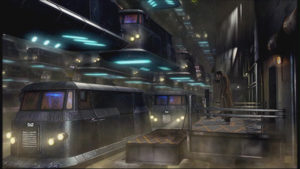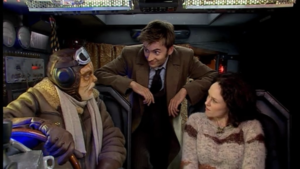 This episode has long been one of my favorites, certainly of season 3, possibly of all Doctor Who. There are so many threads worth following in this thematically rich story: kidnapping, drug addiction, terrible consequences of the human propensity towards excess, repentance and redemption, sacrificial love, and the biggest, longest traffic jam you’ve ever seen.
This episode has long been one of my favorites, certainly of season 3, possibly of all Doctor Who. There are so many threads worth following in this thematically rich story: kidnapping, drug addiction, terrible consequences of the human propensity towards excess, repentance and redemption, sacrificial love, and the biggest, longest traffic jam you’ve ever seen.
It’s the traffic jam I want to focus on.
The Doctor brings Martha to New New York (a place we’ve visited in each season of Doctor Who thus far) only to find it much changed. In the first five minutes, they learn that it is a cultural norm to “buy moods” (i.e. drugs), and Martha is abducted at gun point by a young married couple who run off and shove her into a van. The Doctor is hot on their heels but ultimately too late: he quickly discovers that the futuristic motorway of New New York is packed floor to ceiling, tail-to-nose with cars, the air thick with smog and unbreathable, and the van holding Martha has completely disappeared into the mass.
Driven by his need for air and information, the Doctor jumps aboard the next passing car and meets Thomas Kincade Brannigan and his wife Valerie, who help him understand the unusual nature of the gridlock: they’ve gone 5 miles in 12 years. Everyone is inching forward, isolated in their own little vehicles, connected only by radio, and all motivated forward by the hope of getting above ground where there is sunlight and jobs and a better life.
If you have more than 2 adult passengers, your vehicle is granted access to the fast lane; there are horror stories that keep some people from traveling the fast lane, but others are desperate enough to try it. This is why Martha has been “carjacked” by Milo and Cheen—they are newly pregnant and have renewed urgency to get where they’re going. With Martha aboard and traveling the fast lane, they expect to arrive at their destination in six years: “just in time for [their son] to start school.”
 This picture of millions of people stuck in the dark, isolated and desperate, lonely and full of longing, is a compelling one. Despite their circumstance—one that has persisted for years—there is a general attitude of trust. Trust in a better life. Trust in the information they have. Trust in the system. At regular intervals, there is a daily contemplation transmitted through everyone’s radio.
This picture of millions of people stuck in the dark, isolated and desperate, lonely and full of longing, is a compelling one. Despite their circumstance—one that has persisted for years—there is a general attitude of trust. Trust in a better life. Trust in the information they have. Trust in the system. At regular intervals, there is a daily contemplation transmitted through everyone’s radio.
Sally (the voice on the radio): “This is for all of you out there on the roads. We’re so sorry. Drive safe.”
Drivers and passengers join together in unison to sing a hymn. After this moment of quiet, there is a sense of renewed hope on the motorway. No matter what logic the Doctor throws at Brannigan and Valerie, they are not deterred from their convictions about their life circumstance and plans for the future.
Doctor: “So we keep on driving.”
Brannigan: “Yes, we do.”
Doctor: “For how long?”
Brannigan: “Till the journey’s end.”
In this episode, we are more connected to the Doctor and Martha’s perspective on the situation than to the people on the motorway. Along with our protagonists, we wonder “how can you keep going like this?” “how can you trust there is anything out there?” “how do you know you’re not abandoned?” “how can you have hope?”
The situation does indeed look bleak, and the people of the motorway look silly—no, stupid. There is no hard evidence to confirm the promises on which their hopes are built. At best, they seem innocently brainwashed and pacified by emotion rather than truth. They are sustained by promises and songs and dreams and connection to each other.
This would seem to be a solid argument for the “opiate of the masses” view of religion. Through the course of events, it is discovered that the motorway is completely shut off. There is no evident way out. These people, full of hope, fed on promises of a brighter future, have merely been going around in circles. Even the voice on the radio is a recording rather than a real person.
Oh how often in my (relatively short) life have I felt like a person stuck on the motorway: going around in circles, with no hope to escape, nothing better on the horizon, no one out there to rescue me. Yes, in those seasons, even the Christianity that I cling to seems like vague and empty promises—is anyone truly out there? Where is the evidence to prove it so?
 From all angles, the situation for the people of the motorway is hopeless. But then, something happens. The ceiling is thrown open; the light streams in; and everyone pulls up into the sunlight.
From all angles, the situation for the people of the motorway is hopeless. But then, something happens. The ceiling is thrown open; the light streams in; and everyone pulls up into the sunlight.
I won’t ruin the series of events that leads to this liberation, but it is important to reveal that there is someone above the motorway, and he has literally been giving his life for the people on the motorway. What looks like a cruel prison, hopeless and meaningless, the motorway is in fact the only safe place to be: for a time, it was necessary for them to be kept there. In fact, they would have died otherwise.
This rings true to my life experience. Circumstances that have been painful and seemed to me to be confusing, pointless, even cruel, have later been redeemed: darkness turned towards the light. There are doors that have been closed to me that were not safe to walk through, though from my vantage point, I could not see or understand that.
I do not mean to suggest that all evil or hardship in life is from God’s hand. I believe that the world is fallen, that humans have been given freedom of choice, and that God is a powerful Redeemer. I trust in Romans 8:28 that says “all things work together for good to those who love God and are called according to his purpose,” though often I have to repeat this promise in faith until I can believe it to be so. The intersection of these things is complicated and enigmatic, but I do not believe that I have to understand every mystery for truth to exist. Like the people on the motorway, even when things look terribly bleak and hopeless, I have faith that my hope is not unfounded; that there is actually someone who sits above the world, who sees all things, and who is on my side.

